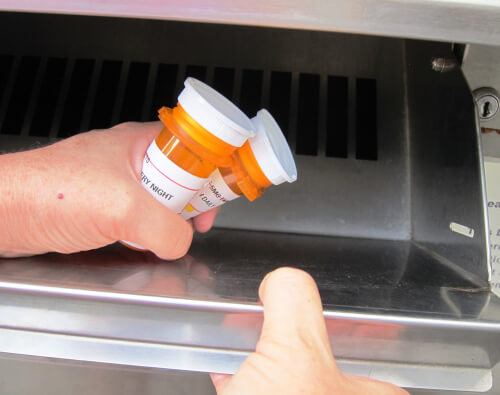Commonly, narcotics are used to relieve potent pain. They also may be used for those who have respiratory problems and for those who suffer from diarrhea. These medications may be obtained naturally, semi-synthetically, and synthetically. The mechanism of action of these drugs is different from one type to another. Some of these drugs give their effects centrally in the brain and spinal cord; others may give their effect peripherally as in the gastrointestinal tract, joints, and respiratory tract.
It is recommended to use these substances only as prescribed by the healthcare provider to avoid the dangerous narcotics effects such as overdose and addiction development.
Learn About Narcotics MOA And Uses:
How Do Narcotics Work?
How do narcotics enter the body and give their effects? The mechanism of action of these drugs is by activating specific receptors located in the central nervous system (brain, spinal cord) and the gut. The effects of these medications appear after administering them into the bloodstream and reaching the brain. The mechanism of action is also different from one substance to another.
How do narcotics work? Narcotics work by blocking the opioid receptors present in the brain, such as mu, delta, and kappa receptors. Generally, they all affect the opioid receptors, but in different ways.
- The MOA of naturally occurring medications such as morphine and synthetic compounds like fentanyl is by activating opioid receptors in the brain (pure agonist).
- The mechanism of action of semi-synthetic medications such as buprenorphine is by binding to and activating opioid receptors, but have only partial efficacy at receptors relative to pure agonists (partial agonist).
- The MOA of some semi-synthetic compounds, such as naloxone and naltrexone, lies in blocking narcotics by attaching to opioid receptors without activating them (pure antagonist).
- The MOA of some synthetic compounds, such as pentazocine and nalorphine, is by their agonist-antagonist effects on opioid receptors.
What Are Narcotics Used For?
There is a narcotics list that used legally because of its pharmacological action. There is also a list of illegal substances which are prohibited by the law and have no approved medical uses. The legal list of narcotics for pain relief contains compounds that may be prescribed by a doctor. What are the medical uses of narcotics drugs? There are several medical uses for narcotics, such as pain relief, for respiratory, and physiological problems.
For Pain
One medical use of narcotics is pain relief. Naturally occurring narcotics act on the central nervous system to give therapeutic effects. Short-acting narcotics are used to relieve acute severe pain after an accident. The doctor can appoint sustained-release narcotics for chronic pain with compliance to the FDA guidelines only.
- The healthcare provider can recommend narcotics after surgery, severe menstrual cramps, and to relieve cancer pain.
- A doctor may choose narcotics for headaches such as migraines. The usage of narcotics for migraines carries a high risk of medication overuse. The overuse of these drugs may trigger acute attacks of migraine to chronic episodes of it.
- Pain narcotics are useful when taking it as prescribed to relieve many types of pain. But it is preferred to use NSAIDs instead of narcotics for back pain to avoid the possibility of abusing it.

There are also different medical uses of narcotics other than pain relief. Naturally occurring medications such as codeine may be used to relieve dry cough centrally and also used in paroxysmal nocturnal dyspnea.
For Anxiety
According to a study published in the Journal of International Medical Research, taking narcotics for anxiety treatment has a good outcome for anxious patients. The use of narcotics for depression treatment has a benefit, especially buprenorphine, which is used at lower doses for reducing suicidal ideation in patients with difficult to treat depression.
For Diarrhea
The use of these drugs for treating diarrhea is achieved by prescribing narcotics such as Diphenoxylate. It slows the gut and thereby reduces the frequency of bowel movements. Diphenoxylate acts depression on the CNS, which, in turn, acts depressively to the stomach. Its chemical structure is similar to the structure of meperidine, which may cause a risk of abuse and addiction development.

Narcotics For Fibromyalgia
Despite the severe pain that fibromyalgia patients may experience, the use of these drugs for fibromyalgia treatment has not been proven effective. Moreover, the use of these medications for fibromyalgia may even worse pain thresholds. So, it is advised not to take fibromyalgia pain medication narcotics as the prolonged use of these drugs for fibromyalgia may cause addiction.
How To Take Narcotics?
How do narcotics enter the body? These medications may enter the body intravenously, orally, topically, and intrathecally. The healthcare provider may prescribe the appropriate way according to a patient pathological condition, medical history, and age.
Oral Use
Oral narcotics may be available in the form of liquid, pills, and capsules. Oral route is preferred for conscious patients but not recommended to the one who suffers from difficulty swallowing.
- Pills And Capsules
The narcotics pills are used to relieve acute and chronic episodes of pain, but their effects appear after intake by 1 to 2 hours. The pills and capsules are not entirely absorbed into the blood as the liver metabolizes them.
- Liquid Drugs
Liquid medication form may be used for those who cannot swallow pills and capsules such as infants and elderly and also for the vomiting patients. The liquid form gives its effect during 15 to 30 minutes of its administration with more rapid absorption than pills and capsules, but it is not entirely absorbed as it is a subject for the first-pass metabolism.

Intrathecal Use
Intrathecal narcotics rapidly relieve labor pain with more safety and efficacy than other alternatives. These medications are administered into the epidural or subarachnoid space for relieving acute and chronic pain. Intrathecal medications don’t affect the natural progression of labor and have no adverse reactions on the fetus.
Parenteral Use
The health care provider may prescribe parenteral narcotics because of their rapid effects. IM and IV narcotics effects appear within a few minutes of administration. The use of IV narcotics for pain relief and supplement sedation during general anesthesia is common. Parenteral medications are entirely absorbed into the bloodstream as they are not a subject for hepatic first-pass metabolism, but they have more dangerous side effects than oral products.
Topical Drugs
A doctor may prescribe topical narcotics for pain relief by applying to the skin. Topical medicines have advantages over other routes. They don’t undergo first pass-metabolism, target pain site only with the lowest accurate dose, and have less systemic side effects.
Rectal Drugs
The healthcare provider may prescribe rectal products to a patient who cannot swallow oral pills and capsules, the vomiting person, and those who cannot tolerate parenteral painful sensation. The effects of the rectal form appear after about one hour of its administration with complete absorption into the blood via rectal mucosa without passing hepatic metabolism.
Snorting Narcotics
Some recreational users practice getting narcotics online or from the streets without a prescription to get euphoric and pleasurable feelings. Attempts to get such drugs without prescription may be punishable by law. Drug abusers crush tablets into a powder and snort it. This route has a rapid onset of action as the drug directly enters the bloodstream through the nasal mucosa.
Recreational use of these medications may cause dangerous side effects and may lead to death. It is advised to take them as prescribed by the healthcare provider only to avoid harmful reactions.
How To Dispose Of Narcotics Safely?
The healthcare provider should talk to patients about the the most appropriate way of disposing of them when it is expired or unused. The best way of disposal of narcotics is through a take-back program that is offered by the U.S. Drug Enforcement Agency (DEA). The unused tablets, capsules, liquids, or other forms of these medications should be disposed of in a take-back dropbox, or by using a mail-back system, or taken to an approved hospital, pharmacy, police departments, fire stations or a DEA authorized collection site. Some pharmacies may offer a free powder product to mix it with narcotics and warm water, so this solid can be safely thrown in the trash. There are guidelines that should be followed while disposing of narcotics:
- Read the disposal instructions on the product labels.
- Scratch out information on the product label so it cannot be read.
- Find out how to flush the medication. The FDA offers a list of medicines that can be safely flushed down the toilet.
- Flushing narcotics is advised if there are no available take-back programs. This is by mixing it with an unpalatable substance such as kitty litter or used coffee grounds. Then place it in a container such as a sealed plastic bag and then throw the container in the trash.
- Keep the trash out of the reach of children or animals
- Do not label the garbage or put any information on it about the active ingredients.
- Place sharps, needles, and syringes immediately in a heavy-duty plastic container when disposing of narcotics.

Safe Use Of Narcotic Drugs
The main recommendation to use these drugs safely is to follow all guidelines that are prescribed by a doctor and not to self-medicate. It is also recommended not to stop taking these drugs suddenly if any side effects appeared and to consult a doctor immediately.
A sudden stopping the use of these drugs without the consultation of the healthcare provider may cause the symptoms of narcotics withdrawal in a person, such as depression, nausea, and agitation.
What do narcotics do when one takes them for recreational purposes? The use of these medications recreationally may lead to dangerous side effects such as respiratory depression and cardiac arrest, and may also increase the risk of addiction development. The proper treating the addiction under the supervision of medical professionals will be required in such case. Finding a suitable rehab facility as soon as possible accelerates the process of recovery.
Take these medications as prescribed and with the accurate sticking to the medical dose. Avoid taking them to get high, because their use for recreational purposes may cause damage to health and overdose.
Page Sources
- Carla Ghelardini, Lorenzo Di Cesare Mannelli, Enrica Bianchi. The pharmacological basis of opioids. 2015.https://www.ncbi.nlm.nih.gov/pmc/articles/PMC4708964/
- Hasan Pathan, John Williams. Basic opioid pharmacology: an update. 2012. https://www.ncbi.nlm.nih.gov/pmc/articles/PMC4590096/
- Roy-Byrne P, Sullivan MD, Sherbourne CD, Golinelli D, Craske MG, Sullivan G, Stein MB. Effects of pain and prescription opioid use on outcomes in a collaborative care intervention for anxiety. 2103. https://www.ncbi.nlm.nih.gov/pubmed/23370069
- Buprenorphine Used With Treatment Resistant Depression in Older Adults (IRLGreyB). 2019. https://clinicaltrials.gov/ct2/show/NCT02181231
- Stephens MB, Ford RE. Intrathecal narcotics for labor analgesia. 1997. https://www.ncbi.nlm.nih.gov/pubmed/9262527
- Where and How to Dispose of Unused Medicines. U.S. Food & Drug Administration. https://www.fda.gov/consumers/consumer-updates/where-and-how-dispose-unused-medicines
More About Narcotics:

 Authored by
Authored by 



